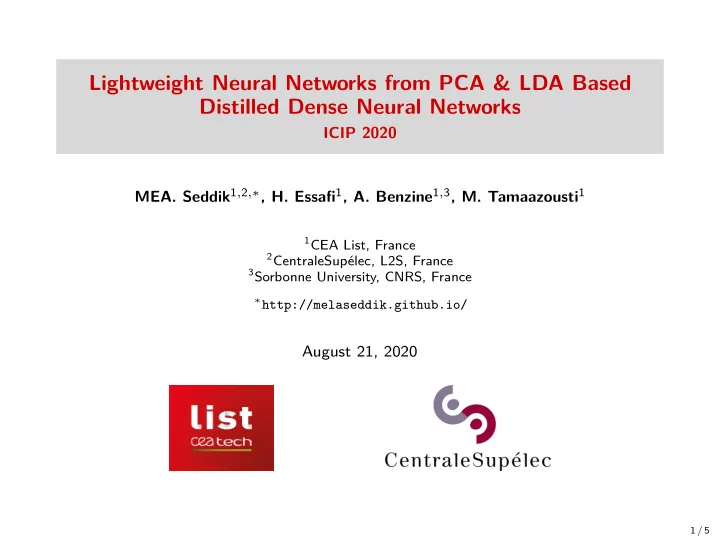

Lightweight Neural Networks from PCA & LDA Based Distilled Dense Neural Networks ICIP 2020 MEA. Seddik 1 , 2 , ∗ , H. Essafi 1 , A. Benzine 1 , 3 , M. Tamaazousti 1 1 CEA List, France 2 CentraleSupélec, L2S, France 3 Sorbonne University, CNRS, France ∗ http://melaseddik.github.io/ August 21, 2020 1 / 5
/ 2/5 Abstract Context: ◮ Compression of dense neural networks with the teacher-student approach. Motivation: ◮ Build lightweight neural networks that can fit into edge and IoT devices with limited resources (memory and computation). Proposed methods: ◮ We proposed two methods which rely on dimension reduction techniques (PCA and LDA). ◮ The dimension reduction is applied at each layer of the teacher net and then mapped to the layers of the student net using a multi-task loss function. 2 / 5
/ 3/5 Setting Given a Teacher Network (TN) trained on a dataset D with loss L TN � h (0) = x ∈ R p 0 (TN) : � W ( ℓ ) h ( ℓ − 1) + b ( ℓ ) � ∀ ℓ ∈ [ L ] h ( ℓ ) = f ℓ ∈ R p ℓ Construct a Student Network (SN) to train on D � h (0) = x ∈ R p 0 ˜ � b ( ℓ ) � (SN) : ∀ ℓ ∈ [ L ] ˜ h ( ℓ ) = f ℓ W ( ℓ )˜ ˜ h ( ℓ − 1) + ˜ ∈ R k ℓ Such that k ℓ ≪ p ℓ & Performance (SN) � Performance (TN) 3 / 5
/ 4/5 Proposed Methods (Net-PCAD & Net-LDAD) Given (TN) , a data matrix X and (TN) loss function L TN For each layer ℓ : 1. Extract the representations H ℓ of X from (TN) 2. Compute a projection matrix U ℓ ∈ R p ℓ × k ℓ through PCA or LDA on H ℓ Train (SN) as a multi-task 1 problem with L − 1 � ℓ h ( ℓ ) � � h ( ℓ ) , U ⊺ ˜ L SN = e − σ L TN + σ e − σ ℓ L mse + + σ ℓ � �� � ℓ =1 Learning Task � �� � (SN) Hidden Layers Task where σ and { σ ℓ } L − 1 ℓ =1 are learnable parameters. 1 Using the Homoscedastic loss function: A. Kendall et al. “Multitask learning using uncertainty to weigh losses for scene geometry and semantics” in Proceedings of IEEE CVPR, 2018. 4 / 5
/ 5/5 Experimental Setting & Results Layer (TN) (SN) Dense 1 p 0 × 1024 p 0 × k Dense 2 1024 × 512 k × k Dense 3 512 × 256 k × k Dense 4 256 × 10 k × 10 Table: Networks architectures. (SN) Datasets (TN) k = 50 100 200 MNIST 2 . 23s 0 . 38s 0 . 45s 0 . 65s 98% 97% 97 . 5% 97 . 8% FASHION 2 . 23s 0 . 38s 0 . 45s 0 . 65s 88% 87 . 5% 88 . 5% 88 . 5% CIFAR10 4 . 63s 0 . 75s 0 . 92s 1 . 35s 45% 50% 50 . 1% 50 . 3% Table: Networks performances. ⇒ k ℓ ≪ p ℓ & Performance (SN) � Performance (TN) 5 / 5
Recommend
More recommend